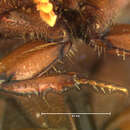Comprehensive Description
provided by Smithsonian Contributions to Zoology
Pseudataenius socialis (Horn)
Ataenius socialis Horn, 1871:287; 1887:76.—Harold, 1874b:174.
Pseudataenius socialis.—Brown, 1927:290.
DESCRIPTION.—Length 4.2 to 5.0 mm; width 1.8 to 2.0 mm. Elongate-oblong, castaneous, shining.
Males: Head short, broad, flat, only very weakly convex, wider through the prominent genae than through anterior angles of the pronotum; finely reflexed clypeal margin broadly rounded each side of shallow median emargination, sides nearly straight to sharply rounded, less than right-angled genae, the genae with a tuft of six to eight, close, moderately long, stiff setae; head surface uniformly, very finely punctate, the punctures separated by about twice their diameters. Pronotum two-thirds as long as wide, sides and base finely margined, fimbriate with long, conspicuous setae, the setae longest at anterior angles where they are separated by about one-third their length and gradually shorter to beyond posterior angles; sides widely arcuate into slightly sinuate base, sometimes with barely a trace of emargination at posterior angles; surface very moderately convex, with close, mixed, quite evenly spaced, very fine to very moderate punctures throughout, a little finer anteriorly at middle, the larger punctures separated in general by one to two or more times their diameters. Elytra convex, long, subparallel, not quite three-fourths as wide as long, humeri not dentate, elytral striae fine and not very deep, strial punctures weakly crenating sides of the feebly convex intervals, tenth interval flat, intervals with scattered, minute punctures more or less in two rows, separated by about four times their diameters. Mesosternum shagreened as usual in Ataenius, without noticeable carina between the coxae. Metasternum with seven or eight moderate punctures plus scattered, minute puncture on each side of long, fine, rather shallow midline, minutely alutaceous with a few close, fine punctures at sides, metasternal triangle shallow, very minutely alutaceous within. First visible abdominal sternum with fine posterior marginal line, second with a trace of a similar line at sides, middle three sterna with very fine fluting along anterior margin, sometimes invisible in some specimens, fluting of 5th sternum only about twice as long, surface of sterna minutely alutaceous with a few usually vague, scattered, fine punctures. Pygidium with wide, smooth apical lip, eroded area deep and rough. Anterior femora without marginal line, surface smooth with a few vague shallow fine punctures. Anterior tibiae narrow with only two large teeth, margin smooth above teeth, spur long, parallel, the tip bent inward. Middle and hind femora like anterior femora but with row of four, quite widely spaced, coarse setigerous punctures over outer half. Posterior tibial apical fringe of eight close setae, a short accessory spine, and an intervening setae between spine and spurs, the latter seta not easily seen. Tarsus of middle and hind legs very long and slender, approximately one-third longer than the tibia; metatarsus longer than long spur, approximately equal to following three segments combined.
Females: Compared with the male the head and pronotum are more convex and much more strongly punctate. Anterior two-thirds of the clypeus transversely wrinkled, posterior clypeus and front finely, closely punctate, the punctures separated by their diameters or a little more. Pronotum with mixed very fine and moderately coarse punctures throughout, the coarse punctures irregularly spaced and a little finer anteriorly at middle, separated generally by less than one to two or three times their diameter. The 4th abdominal sternum is a little larger and the apical lip of the pygidium is not as long at middle. The anterior femora have an anterior marginal line. The anterior tibia has the normal three large teeth and short straight spur.
LECTOTYPE (present designation).—In Academy of Natural Sciences of Philadelphia, presently labeled “Type No. 3609.”
TYPE-LOCALITY.—“Georgia and Louisiana.” The lectotype is labeled simply “La.”
SPECIMENS EXAMINED.—34.
DATES COLLECTED.—May 31 to July 15.
DISTRIBUTION (Figure 2).—Kansas: Lawrence, Maple Hill, Ottawa, Topeka. Louisiana: Harahan, Morgan City, Raceland. Nebraska: Lancaster County, Lincoln. Oklahoma: Noble County (in Cynomys hole). Texas: Columbus, Houston.
- bibliographic citation
- Cartwright, Oscar Ling. 1974. "Ataenius, Aphotaenius, and Pseudataenius of the United States and Canada (Coleoptera: Scarabaeidae: Aphodiinae)." Smithsonian Contributions to Zoology. 1-106. https://doi.org/10.5479/si.00810282.154
Pseudataenius socialis: Brief Summary
provided by wikipedia EN
Pseudataenius socialis is a species of aphodiine dung beetle in the family Scarabaeidae. It is found in North America.
- license
- cc-by-sa-3.0
- copyright
- Wikipedia authors and editors

